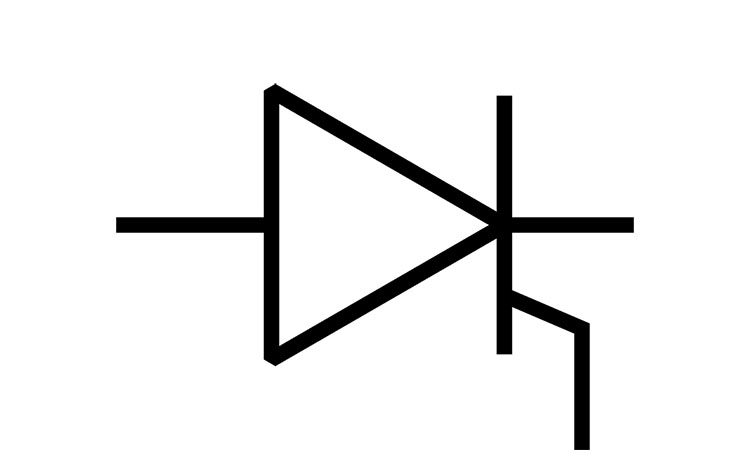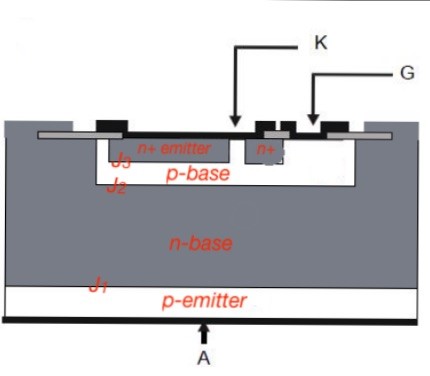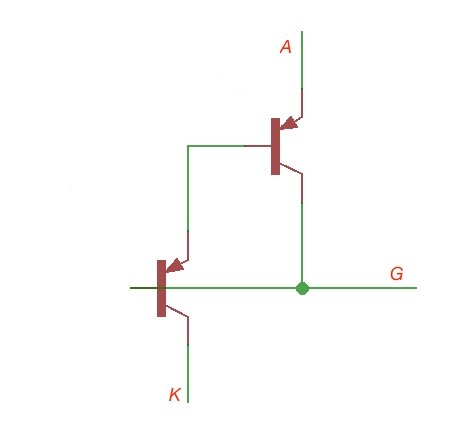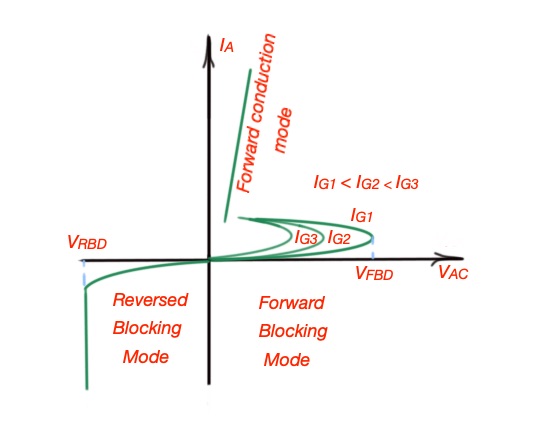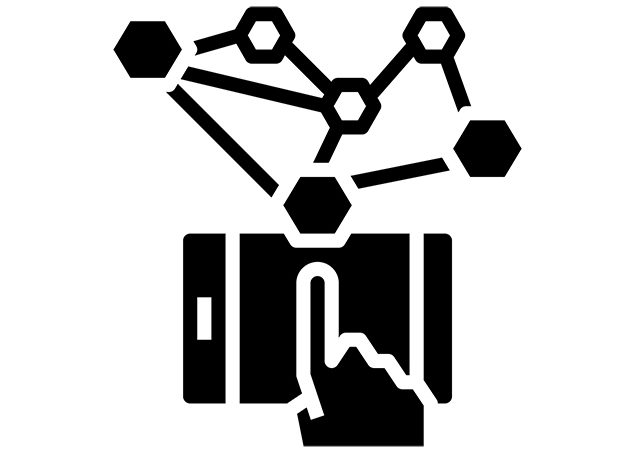A power thyristor is the three terminal, bi-stable device, with alternating p- and n-layers in its structure.
Its simplified scheme, equivalent scheme and sign are depicted in Figure 1.
a – thyristor layers scheme
b – thyristor electrical sign
c – thyristor equivalent scheme
Figure 1. The standard thyristor.
The control terminal of the thyristor is the gate terminal. It should be connected to the integrated structure of a device. The other two terminals are cathode (K) and anode (A), and carry currents and applied potentials. The anode and cathode are usually connected in parallel to the load to control the power.
If the thyristor is closed there is no voltage drop between the cathode and anode. If the thyristor is open, there is no current though the anode. Thyristors work like switches, from the forward-blocking to forward-conducting state. Thyristors are usually characterised with the latching characteristics, i.e. when they switch from forward-blocking to the forward-conducting state, the gate signal can be removed.
Thyristors are designed to carry high power levels, and typically currents are bigger than 100A, and voltages are bigger then 1kV. This distinguishes them from power MOSFETs, IGBTs and other semiconductor devices.
Let’s take a look at the thyristor structure. It features a region with high resistance, n-region, associated with the interface. This region usually supports high voltages, it is heavily doped to the concentration to , with the thickness between 10 and a few 100μm.
The p-regions are usually thin, about a few tens of micrometres thick, with doping concentration to . The cathode region is usually even thinner – only a few micrometres, with higher doping quantities to .
A very useful curve to help find the static characteristics of the thyristor is the current-voltage curve, with anode current versus anode-cathode voltage.
Figure 2. The current-voltage curve for standard thyristor.
The characteristics that describe thyristors are the following (all are usually listed in the manufacturer’s datasheet for the thyristor):
- Peak repetitive reverse voltage ;
- Peak non-repetitive reverse voltage ;
- DC reverse blocking voltage ;
- Peak repetitive off-state voltage ;
- Peak non-repetitive off-state voltage ;
- DC forward blocking voltage ;
- RMS forward on-state current ;
- Average forward on-state current for specified junction temperature ;
- Peak on-cycle surge on-state current ;
- Peak controllable current ;
- Non-repetitive overload capacity ;
- maximum power dissipation;
- Critical rate of rise on-state current at specified ;
- Peak gate power dissipation (forward) ;
- Peak gate power dissipation (reverse) ;
- Average gat power dissipation ;
- Peak forward gate voltage ;
- Peak reversed gate voltage ;
- Peak forward gate current ;
- Peak reversed gate current;
- Storage temperature .
- Junction operating temperature ;
- Voltage isolation .
Key advantages of thyristors
- It can work with the AC voltages without adding additional diode;
- Can withstand high load current;
- Lathing property;
- Zero-current turn-off;
- Overload capacitance.
The thyristor can work with AC power circuits to control the AC power flow. The thyristor can also work with the DC power circuits for converting DC current/voltage into the AC current/voltage. Thyristors can be categorised into four :
- silicon-controlled rectifier (SCR);
- gate turn-off thyristor (GTO);
- MOS-controlled thyristor (MCT);
- Static induction thyristor (SITh).
Thyristor operation mode
Current-voltage characteristics of a thyristor is represented by the function of anode current and anode-cathode voltage, is outlined on the figure below.
Thyristor can operate in three modes.
When positive voltage is applied to anode and negative – to cathode, gate is kept at zero voltage. Here junctions and are forward biased, and junction is reverse biased. Only very small leakage current can go through junction , so thyristor is in OFF state. This mode is called forward blocking mode.
When we are applying a gate pulse between cathode and gate, thyristor goes to the ON state, and behaves like a switch in ON state. This mode is called forward conduction mode.
When cathode is experiencing positive voltage comparing to anode, thyristor is reverse biased. Junctions and are reverse biased and behave like two diodes in series. The thyristor is in OFF state and this mode is called reverse blocking mode. A small leakage current is still available through the thyristor.
If reverse voltage will increase, reaching certain level, called reversed breakdown voltage, junctions and will experience quickly growing current.
What should we keep in mind working with power thyristors
is a rate of anode current rise. is a rate of anode-cathode voltage rise. These two parameters are important to control to ensure effective thyristor operation. They also have their limits. The main reason of thyristor failure operation can be excessive local current density of cathode region, that leads to overheating. That is why it is important to control the rate of anode current rise through thyristor.Thyristor is characterised with specific junction temperature, that is critical temperature for device to be controlled and not exceeded. When blocking voltage is increases, the junction temperature is decreasing.
Another problem may happen during thyristor turn off, when forward voltage is growing with existing current through the device, thyristor can switch to conduction mode instead of turn off mode, that can follow by failure. Another situation here is power dissipation may become too big when current and voltage are increasing during turn off mode, that follow by the device damage as well.
If is too large thyristor may switch from forward blocking mode to forward conduction mode.
Power thyristor characteristics
Looking at the power thyristor datasheet we can observe two types values:
- Rated values, are maximum and minimum values for correct device operation;
- Characteristic values, are measured device value at certain conditions.
Referring to the list of thyristor parameters, it is important to control and not exceed and values, as it may lead to thyristor failure.
is a maximum current rating that will cause to reaching maximum of junction temperature. is maximum junction temperature, that should not be exceeded.Digi-Key Electronics offers great selection of power thyrsitors.

